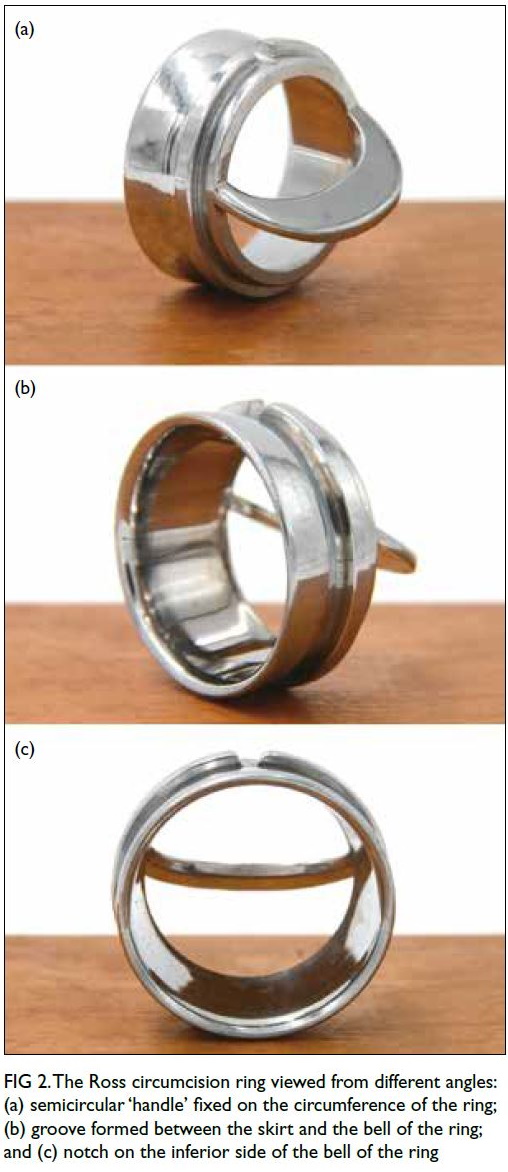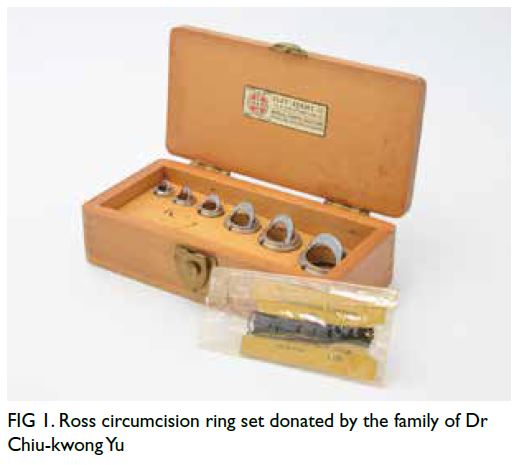© Hong Kong Academy of Medicine. CC BY-NC-ND 4.0
REMINISCENCE: ARTEFACTS FROM THE HONG KONG MUSEUM OF MEDICAL SCIENCES
The Ross circumcision ring
CW Fong, FHKAM (Surgery)
Guest Author, Education and Research Committee, Hong Kong Museum of Medical Sciences
The Ross circumcision ring was invented by Dr
Cecil J. Ross and first patented in the United States
in 1942.1 It was designed to make the performance
of circumcisions simpler and quicker, while also
achieving a uniform and aesthetic result. This was
possible because it allowed the removal of excessive
foreskin, haemostasis, and wound approximation to
be achieved with a single ligature.
The set contains differently sized steel rings to
suit varying penile sizes (Fig 1). On one side of each
ring is a semicircular ‘handle’ fixed diametrically at
two points on the circumference of the ring such
that it is set at an angle to its main axis (Fig 2a). From
the inner circumference on the other side a short
skirt extends outwards to form a bell, with a groove
formed between the skirt and the ring (Fig 2b). There
is a notch on the inferior side of the bell (Fig 2c).

Figure 2. The Ross circumcision ring viewed from different angles: (a) semicircular ‘handle’ fixed on the circumference of the ring; (b) groove formed between the skirt and the bell of the ring; and (c) notch on the inferior side of the bell of the ring
When used, a bell of an appropriate size is
placed on the glans of the penis after its adhesion
with the prepuce is broken. The prepuce, in most
cases after a dorsal slit, is comfortably (ie, without
excessive difficulty and force) pulled over the bell,
the notch clearing the frenulum on the ventral
side, and the handle aligned in the long axis of the
penile shaft, whereupon the coronal plane of the
ring becomes, by design, oblique, falling parallel to
the coronal sulcus. A tight ligature is tied down on
the bell against the groove between the skirt and the
ring, achieving total strangulation of the distal part
of the prepuce. The redundant prepuce beyond the
ligature is generously excised and trimmed down to the edge of the ring to reduce the bulk of skin that
would inevitably become gangrenous subsequent to
the strangulation; minimal or no bleeding would be
expected due to the tight proximal ligature. Necrosis of the skin under and distal to the ligature occurs any
time after 72 hours, at which point the ring falls off
with the dead skin, leaving a freshly healed wound
and a glans denuded of excessive foreskin. The ring
is retrieved, cleansed, and sterilised for re-use. The
wound takes a few more days to be securely healed.
The Ross ring would later evolve into the
Plastibell, which has a similar design but is made
of plastic and is thus disposable; the handle is also
attached to the ring using an easily breakable design,
allowing it to be removed at the end of the procedure.
The Plastibell was marketed in 1955 and granted a
patent in 1962, largely because of the novelty of the
breakable handle, although the changed material
from metal to plastic and the gross similarity to the
Ross ring would not have helped.2
The methods of circumcision are as diverse as
its history is long (see below) and any attempt to list
them exhaustively would be beyond the scope of this
article. Suffice to say that surgeons of time past, and
of the present day as well, were all familiar with and
widely practising the tailor-cut and suturing method,
in which the excessive length of the prepuce would
be excised, tailored to need, and after adequate
haemostasis with monopolar or bipolar cautery, the
wound would be closed with sutures.
History of circumcision
The history of circumcision goes back to the era of
ancient Egypt, as evidenced by the discovery of a
depiction of it being performed on the east thickness
of a doorway to Ankhmahor’s tomb, dating back to
the reign of Pharoah Teti (2355-2343 BC) of Dynasty
6.3
Circumcision was also practised as a religious
rite in the Abrahamic faiths of Judaism and Islam.
The patriarch Abraham originally lived in Ur, then
an advanced and sophisticated Mesopotamian city
where Sumerians and Semites mixed. According
to the Bible, Abraham had a covenant with God
that he and his descendants would be circumcised
with a flint blade on the eighth day after birth as a
symbolic reminder of the promises the Lord made
to Abraham regarding his posterity (Genesis 17:11-14); since Islam recognises Abraham as a prophet,
Muslims practised a similar ritual, but it was
done in adolescents rather than neonates. Today,
circumcision is still widely practised by Jews and
Muslims worldwide. In Israel, newborn boys are
circumcised in a traditional ceremony called a brit
milah, where the foreskin is removed by a mohel,
more a rabbi than a medical practitioner.4
From Egypt the practice spread both north
and south. There is evidence that it was prevalent
in modern-day Syria, Lebanon, and the Arabian
Peninsula from 600 to 500 BC. The southward
spread reached across the Sahara as far as the
banks of the Niger River, and along the east coast
of Africa to Somalia and Ethiopia through people
of Sumerian and Semitic origins. Between AD 500
to 1000 it spread further south to the tribal people
of Mozambique; today, the Bantu peoples of South
Africa are still performing ritual circumcision.5
Circumcision as a cultural practice
and preventive healthcare measure
In Oceania, circumcision was a rite of passage to
adulthood for the Aboriginal and Polynesian peoples.
In these cultures, the foreskin was removed with
seashells and haemostasis achieved by the individual
squatting or standing for several hours over the smoke
from a fire covered with eucalyptus leaves, with the
blood dripping into the fire considered symbolic of
one’s sympathy with women’s menstruation.5
At the turn of the 19th century, some
claimed that infant circumcision would discourage
masturbation, with all its associated ‘ills’. In the
Second World War, the Korean War, and the
Vietnam War, circumcision was recommended to
the United States troops as a preventive measure
against sexually transmitted diseases. Circumcision
has now been shown to reduce the infection rate of
human papillomavirus and therefore the incidence
of cervical cancer. Since the association of human
immunodeficiency virus infection and acquired
immunodeficiency syndrome and uncircumcision
was first established the procedure has been gaining
popularity.
References
1. Ross CJ, inventor; Cecil J Ross. Circumcision ring. US patent 2,272,072. May 22, 1939.
2. Circlist. Available from: https://circlist.com. Accessed 14 Jul 2023.
3. Brondz I, Asianova T. Circumcision: history, scope, and aim: part I. Voice of the Publisher 2019;5:77-87. Crossref
4. Kacker S, Tobian AA. Male circumcision: integrating tradition and medical evidence. Isr Med Assoc J 2013;15:37-8.
5. Doyle D. Ritual male circumcision: a brief history. J R Coll Physicians Edinb 2005;35:279-85.


